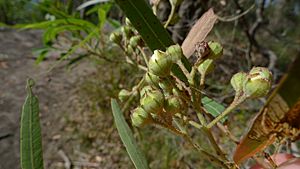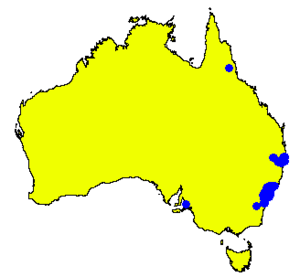Narrow-leaved apple facts for kids
Quick facts for kids Narrow-leaved apple |
|
|---|---|
 |
|
| Flower buds of Angophora bakeri in Jannali | |
| Scientific classification | |
| Genus: |
Angophora
|
| Species: |
bakeri
|
 |
|
| Occurrence data from AVH | |
The Angophora bakeri, often called the narrow-leaved apple, is a type of tree that grows only in New South Wales, Australia. It has rough, stringy bark on its trunk and branches. Its adult leaves are shaped like a spear. The tree produces flower buds in groups of three or seven. Its flowers are white or creamy white, and its fruit is oval or cylinder-shaped.
What Does the Narrow-leaved Apple Look Like?
The Narrow-leaved apple tree usually grows to be about 10 to 18 metres tall. It has rough, grey bark that feels like fibres on its trunk and branches. This tree can also regrow from a special woody lump called a lignotuber if it gets damaged.
Young plants and new shoots have long, narrow leaves. These leaves are about 50 to 100 millimetres long and 4 to 10 millimetres wide. They grow in pairs directly opposite each other on the stem.
Adult leaves are thin and shiny green. They are paler on the underside. These leaves are also long and narrow, measuring about 60 to 130 millimetres long and 5 to 10 millimetres wide. They grow on a small stalk called a petiole, which is 3 to 10 millimetres long. Like the young leaves, they also grow in opposite pairs.
The tree's flower buds grow at the ends of its branches. They appear in groups of three or seven. Each group sits on a main stalk, called a peduncle, which is 7 to 18 millimetres long. The individual buds are on smaller stalks, called pedicels, which are 4 to 11 millimetres long. When the buds are ready to open, they are about 4 to 5 millimetres long and 4 to 6 millimetres wide.
The flowers have five small leaf-like parts called sepals, which are up to 1 millimetre long. The petals are about 3 millimetres long and wide. This tree blooms from December to February. Its flowers are either white or creamy white. After flowering, the tree produces fruit. This fruit is a pale brown or grey capsule that is oval to cylinder-shaped. It measures about 8 to 10 millimetres long and wide and has ribbed sides.
How Did It Get Its Name?
The Angophora bakeri was first officially described in 1913. This was done by a person named Edwin Cuthbert Hall. He wrote about it in a scientific journal called the Journal and Proceedings of the Royal Society of New South Wales. The second part of its scientific name, bakeri, was chosen to honour Richard Thomas Baker.
In 1986, another scientist named G.J.Leach described two different types, or subspecies, of Angophora bakeri. These names are now officially accepted:
- Angophora bakeri subsp. bakeri has thin, flexible leaves. This type is found in many places.
- Angophora bakeri subsp. crassifolia has stiff, thicker leaves. This type is mostly found in the Ku-ring-gai Chase National Park.
Where Does It Grow?
The Narrow-leaved apple tree prefers to grow in sandy soil that sits over sandstone. You can find it in many places from Port Stephens down to Nowra. It also grows as far west as Katoomba.
There is also a separate group of these trees that grows far away from the main population. This group is in the Gibraltar Range National Park. It used to be known by a different name, Angophora exul, but now scientists consider it to be the same as A. bakeri subsp. bakeri.

